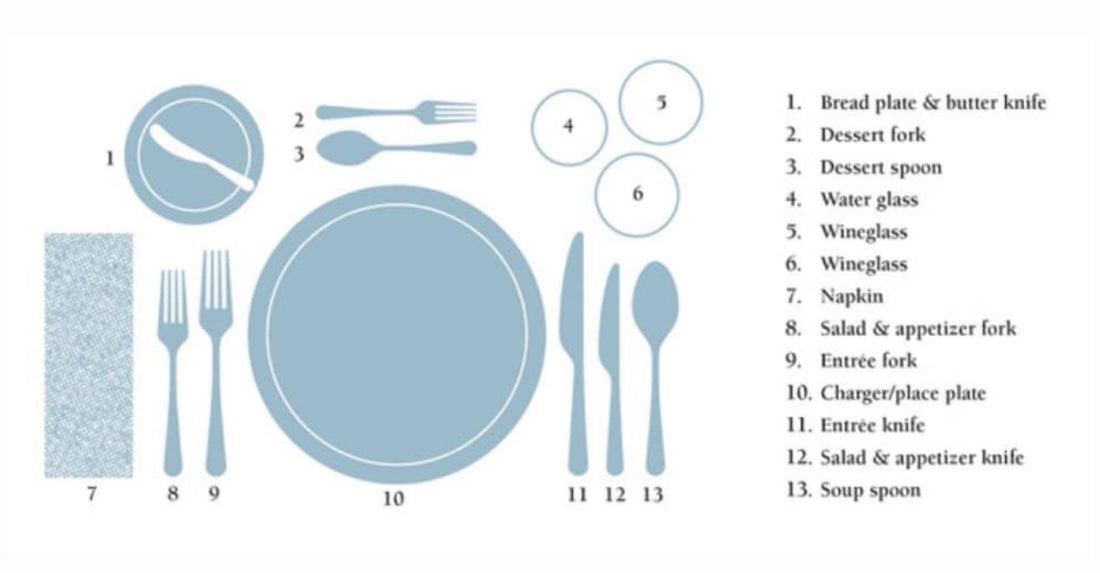
Mastering Utensil Etiquette with Style
Forks, Knives, and Spoons, Oh My!
Mastering Utensil Etiquette with Style
Picture this: you’re at a beautifully set dinner party, the table sparkling with fine china, crystal glasses, and… a baffling array of forks, knives, and spoons. Suddenly, the meal feels like a high-stakes episode of Utensil Survivor. Don’t worry—you’re not alone! Utensil etiquette might seem intimidating, but with a few simple rules (and a little humor), you’ll be navigating even the fanciest settings with confidence.
The Golden Rule: Work from the Outside In
Formal place settings are like an onion—layers upon layers. The utensils farthest from your plate are for the first courses, and as the meal progresses, you work your way inward. Think of it as a culinary treasure hunt.
Example:
• Salad course? Grab that small fork on the outside.
• Soup? That oversized spoon way out there is calling your name.
• Steak? By the time you reach it, your trusty dinner knife and fork will be front and center.
The Anatomy of a Place Setting
Let’s break it down like a fancy puzzle:
1. Forks on the Left:
• The salad fork is smaller and placed on the outside.
• The dinner fork is larger and sits closer to the plate.
2. Knives and Spoons on the Right:
• The knife goes closest to the plate, blade facing in.
• A soup spoon, often larger, sits farther out.
3. Dessert Utensils:
• Often, a small spoon or fork is placed horizontally above the plate. But if not, they might arrive with dessert—because even utensils love to make a grand entrance.
Pro Tip: Watch the Host or Hostess
If you’re unsure, take a cue from your host. The person leading the meal will naturally start with the right utensil, so just follow their lead.
Common Questions and Fun Facts
Q: What if I grab the wrong fork?
Relax! No one will call the utensil police. (And if they do, you probably shouldn’t dine with them again.) Just discreetly switch to the correct one when you notice.
Q: What’s the weird little fork for?
That’s a seafood fork, often used for shellfish like shrimp or oysters. If there’s one on the table, it’s a sign you’re in for something fancy.
Q: Why does the knife blade face the plate?
This is an etiquette tradition symbolizing peace. Back in the day, it showed your dining companions that you weren’t planning to challenge them to a duel over the last bread roll.
Utensil Confidence Is Key
At the end of the day, etiquette isn’t about being perfect—it’s about making your fellow diners feel comfortable. A little charm and a sense of humor go a long way.
QUIZ: Are You a Utensil Master?
Test your knowledge with these fun scenarios!
1. The first course is soup. Which utensil do you grab?
a) The small fork on the outside.
b) The large spoon farthest to the right.
c) The knife closest to the plate.
2. The dessert arrives, but no utensils are on the table. What do you do?
a) Use your salad fork—it’s the closest size match.
b) Wait for the server to bring the dessert utensils.
c) Politely ask for a spoon.
3. You accidentally use the wrong fork for the salad. What’s your next move?
a) Laugh it off and keep eating with the same fork.
b) Quietly switch to the correct fork when you notice.
c) Ask your neighbor for guidance.
4. Why does the knife blade face the plate?
a) To protect the tablecloth.
b) As a historical sign of peace.
c) Because it’s easier to pick up that way.
Answers:
1. b) The large spoon farthest to the right.
2. b) Wait for the server to bring the dessert utensils.
3. b) Quietly switch to the correct fork when you notice.
4. b) As a historical sign of peace.
Conclusion
Now that you know the secrets of utensil order, you’re ready to conquer any formal dinner party with grace and style. So grab that salad fork, dive into your soup spoon, and enjoy the art of dining like a pro. After all, it’s not just about the food—it’s about the experience.
Stay tuned for more tips and tricks to elevate your next dinner party!
